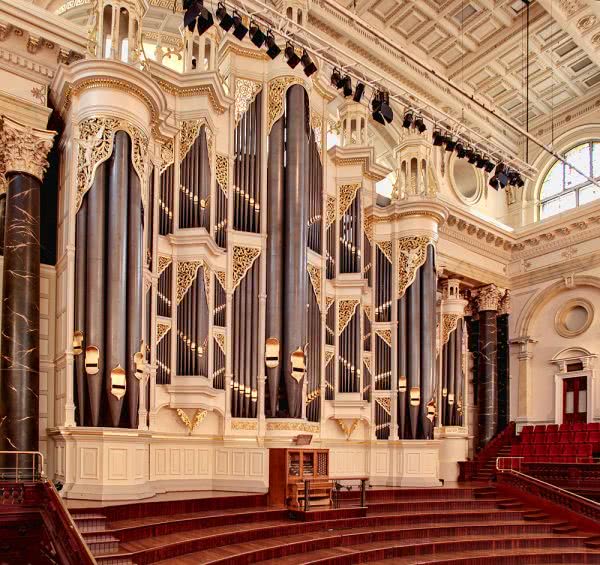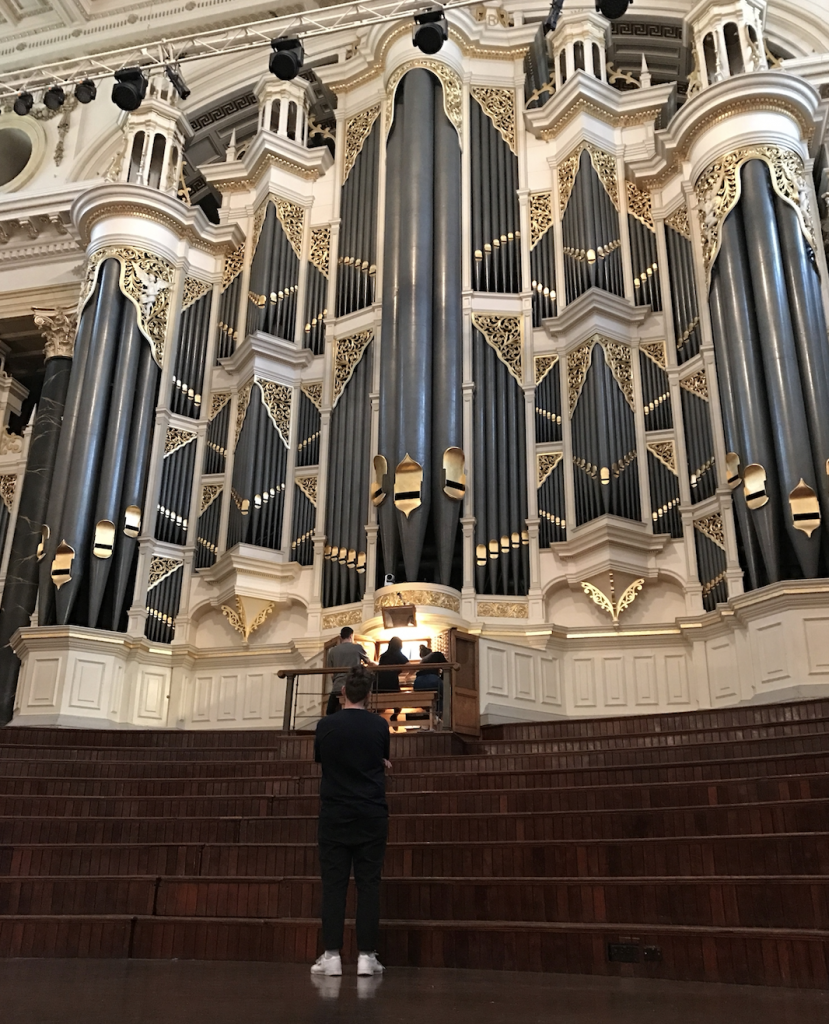Meet the muso making experimental music with Sydney Town Hall’s 127-year-old organ

Anyone who has stepped foot in Town Hall has seen it – gawked at it, most likely. It is the centrepiece of the room, a massive instrument of almost 9000 pipes that took three years to construct and was unveiled 127 years ago. The Grand Organ is a remarkable feat of musical innovation, and as the City of Sydney celebrated its 175th birthday last week, innovation was again on the agenda as experimental composer Austin Benjamin Buckett breathed contemporary life into this icon of the city’s past.
“The organ was commissioned by the city council as part of the building of Sydney Town Hall,” City of Sydney historian Lisa Murray explains of the unique project. “[Town Hall] was built in two stages, between 1864 and 1889. The main part, which most people think of as the Town Hall, is actually the big Centennial Hall, which was the second stage. As part of that, William Hill & Son were the successful tenderer to design and build [the organ]. It was built in England, and installed in 1890. At the time it was the largest in the world, and described as one of the finest organs ever built by an English organ builder.”
 The Sydney Town Hall Grand Organ
The Sydney Town Hall Grand Organ
“There are many stereotypes that come to mind when you think of music for the organ,” Buckett admits. “Phantom of the Opera, church music, classical music associations. But in many ways the organ is the world’s first synthesiser and the earliest example of this idea of imitative presets, which are everywhere in current electronic music production.
“The pipe organ is an example of this embodiment of an instrument that represents a variety of instrumental colours. I think this really highlights how adaptable the pipe organ is in being able to function in producing new music. I’m interested in subverting traditional ideas of how a pipe organ should be played and composed for, while extending on these rich historical aspects of the instrument, its design and its repertoire, in creating something experimental and new.”
It is perhaps unfair, but over time the grand organ has indeed become somewhat shackled to traditional imagery. For many, the reason behind this is simply a matter of exposure; we rarely hear organ music today, so it’s no surprise it may seem rather dusty in our appreciation. But with this City of Sydney collaboration, people are going to experience the potential of the organ in all its grand glory.
“Pipe organs were very much a part of the civic spirit of town halls,” Murray notes. “They were places of entertainment for the populace. At the time, the [Sydney Town Hall] organ was the real cutting edge of design, of pushing the boundaries of music performance, and what we wanted to do with this anniversary was to celebrate the unique qualities of pipe organs, and encourage a young composer to consider how they might explore the organ’s sounds in a contemporary way.
“William Hill & Son actually included a new feature in this organ, a full-length 64-foot pedal stop. It had never previously been attempted, and this very long pipe produces this extremely low sound, which gives a very unique underpinning to grand moments of organ playing, and it’s one of the things that Austin is exploring in his composition.”

Austin Buckett at the Grand Organ
“Many [of my] projects explore a fascination I have with repetition,” Buckett explains, “and how hearing something repeated can shape and re-shape our perception of it. Imitations for the Town Hall pipe organ explores these ideas through reoccurring harmonies that are built through a repeated action of performers assembling and re-assembling bolts on the five keyboards of the organ – I use bolts as weights as there are more sustained notes stacked than playable by two hands – and different stop/sound combinations.
“Repetition is certainly a unifying concern in my work, as is an obsession with pre-existing sounds that are inherently imitative in their nature and function as tools for re-use. From DX7 bell presets, stock drum kit sample packs, to flute sounds being imitated or represented by the pipe organ.”
With the special performance, City of Sydney and Buckett himself hoped that contemporary audiences would witness the grand organ in action, and find themselves amazed at the instrument’s versatility – a chance to see how such an ornate piece of musical history can be carried forward into the future.
“I think all genres and stylistic lineages in music and art create their own dogmas and fixed ideas,” Buckett says. “A concert springs to mind recently when some contemporary classical music was performed where everyone had to be seated, and a kid turned back and looked at me with this face that looked so fed up and bored.
“The idea that you are obliged to inform yourself of the standards of something to fully experience it as a listener can be very damaging. We all perceive things differently and this is something to be embraced by any artist or organisation.
“A sense of excitement would be more encouraged if we present the things we are truly interested in, as opposed to the things we think we should be doing. This is why initiatives such as this are so important in extending the life and reach of the pipe organ into a contemporary landscape, through presenting new ideas and approaches on a historically significant instrument of our city, to the public for free.”
We’re working with the City Of Sydney to tell the stories of Sydney’s live music scene.
The free premiere performance of Austin Buckett’s composition was held at Town Hall on Sunday 5 November as part of the Our City: 175 Years in 175 Objects exhibition.
This article originally appeared on The Industry Observer, which is now part of The Music Network.






























